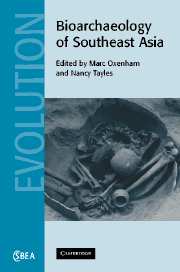Book contents
- Frontmatter
- Contents
- List of contributors
- Foreword: Emerging frontiers in the bioarchaeology of Southeast Asia
- Preface
- 1 Introduction: Southeast Asian bioarchaeology past and present
- Part I Morphological diversity, evolution and population relationships
- Part II Health, disease and quality of life
- 8 Subsistence change and dental health in the people of Non Nok Tha, northeast Thailand
- 9 Human biology from the bronze age to the iron age in the Mun River valley of northeast Thailand
- 10 Palaeodietary change among pre-state metal age societies in northeast Thailand: a study using bone stable isotopes
- 11 The oral health consequences of the adoption and intensification of agriculture in Southeast Asia
- 12 Cranial lesions on the late Pleistocene Indonesian Homo erectus Ngandong 7
- 13 ‘The predators within’: investigating the relationship between malaria and health in the prehistoric Pacific Islands
- Part III Conclusions
- Index
- References
13 - ‘The predators within’: investigating the relationship between malaria and health in the prehistoric Pacific Islands
Published online by Cambridge University Press: 18 November 2009
- Frontmatter
- Contents
- List of contributors
- Foreword: Emerging frontiers in the bioarchaeology of Southeast Asia
- Preface
- 1 Introduction: Southeast Asian bioarchaeology past and present
- Part I Morphological diversity, evolution and population relationships
- Part II Health, disease and quality of life
- 8 Subsistence change and dental health in the people of Non Nok Tha, northeast Thailand
- 9 Human biology from the bronze age to the iron age in the Mun River valley of northeast Thailand
- 10 Palaeodietary change among pre-state metal age societies in northeast Thailand: a study using bone stable isotopes
- 11 The oral health consequences of the adoption and intensification of agriculture in Southeast Asia
- 12 Cranial lesions on the late Pleistocene Indonesian Homo erectus Ngandong 7
- 13 ‘The predators within’: investigating the relationship between malaria and health in the prehistoric Pacific Islands
- Part III Conclusions
- Index
- References
Summary
Introduction
The success of human settlement in tropical environments was undoubtedly influenced by the presence of infectious disease. Of the tropical diseases, malaria has caused more human suffering and death than any other infectious disease (Bloland et al. 1998). Considering the continued onslaught of malaria, despite intensive medical treatment and research, the cost to prehistoric populations must have been profound. The Pacific Islands provide an invaluable opportunity for examining the potential effects of malaria on prehistoric populations by the variable endemicity among western island groups and its complete absence east of Vanuatu.
Human settlement of the western Pacific Islands has been very long. Yet, despite the development of agriculture in the Holocene, populations in Near Oceania remained small and technological advancement was limited. (Near and Remote Oceania define geographical regions in the southwest Pacific Islands (Green, 1997) that have distinct ecological and geological influences on prehistoric human settlement (Fig. 13.1).) This is a markedly different pattern from the demographic shift seen in other regions of the world where agriculture was developed. Based on epidemiological, entomological and archaeological evidence, Groube (1993, p. 166) suggested that economic development and population increase in Near Oceania was retarded compared with Asian contemporaries because of ‘…the role in Sahuland prehistory of the “predators within”, the parasites of infectious diseases, particularly the presence in Melanesia, and probably northern Australia as well, of that most ancient of human-specific diseases, malaria.’
- Type
- Chapter
- Information
- Bioarchaeology of Southeast Asia , pp. 309 - 332Publisher: Cambridge University PressPrint publication year: 2006
References
- 17
- Cited by

